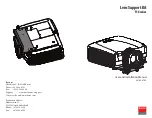
Manual, F/T Sensor, Ethernet Axia
Document #9620-05-C-Ethernet Axia-02
Pinnacle Park • 1031 Goodworth Drive • Apex, NC 27539 • Tel:+1 919.772.0115 • Fax:+1 919.772.8259 •
C-8
Term
Definitions
IP Address
An IP Address (Internet Protocol Address) is an electronic address assigned to an
Ethernet device so that it may send and receive Ethernet data. IP addresses may be
either manually selected by a user or automatically assigned by the DHCP protocol.
Java™
Java is a programming language often used for programs on webpages. The
Ethernet Axia demo is a Java application. Java is a registered trademark of Sun
Microsystems, Inc.
MAC
Media Access Controller is the hardware that implements the lowest sub-layer of the
data link layer.
MAC Address
MAC Addresses (Media Access Control Addresses) are the unique addresses
given to every Ethernet device when it is manufactured, to be used as an electronic
Ethernet serial number.
MAC ID
Media Access Code Identifier (MAC ID) is a unique number that is user assigned to
each device on an Ethernet network. Also called Node Address.
Measurement Uncertainty
Commonly referred to as “accuracy”, “measurement uncertainty” is the worst-
case error between the measured value and the true load. The measurement
uncertainty is specified as a percentage of the full-scale measurement range for
a given sensor model and calibration size. This value takes into account multiple
sources of error. The sensor’s calibration certificate lists the measurement
uncertainty percentage. For more information, refer to
Section 2.2: Measurement
Uncertainty
in the Frequently Asked Questions (FAQ) document located at:
https://www.ati-ia.com/library/documents/FT_FAQ.pdf
.
Mechanical Coupling
When an external object such as customer tooling or utilities contacts a sensor’s
surface between the sensor’s mounting side and tool side.
N/A
Not Applicable
NVM
Non-Volatile Memory. Storage of information or device memory that can be retrieved
even after the device goes through a power cycle.
Overload
The condition where more load is applied to the sensor than the rated measurement
range that can be applied to the sensor. Overloads result in reduced accuracy and
potentially reduced sensor life.
Plug-in Technology
A customized program that when downloaded and installed onto a host device adds
a specific feature to an existing computer program.
P/N
Part Number
Power Cycle
When a user removes and then restores power to a device.
REAL
Floating-point number (32 bit)
RDT
The rate per second at which the sensor sends streaming RDT data to a
host.
Raw Data Transfer (RDT) is a fast and simple Ethernet protocol for control and
data transfer via UDP.
RDT Buffer Size
A mode where the sensor sends more than one data package per sample. Multiple
data packages are buffered and sent in one block. Buffering reduces the amount of
overhead data sent from the sensor and reduces the overall network traffic.
Sensor Reference Frame Origin
The point on the sensor from which all forces and torques are measured.
Sensor System (or
configuration)
The entire assembly consisting of a sensor body and a system interface to translate
force and torque signals into a specific communication interface/protocol.
Resolution
The smallest change in load that can be measured.
Sample Rate
How fast the ADCs are sampling inside the unit.
Sensor
The component that converts a detected load into electrical signals.
SINT
Signed short integer (8 bit)
STRING
n
String of
n
characters
Status Bit
A unit of computer data sent from the ATI F/T sensor.









































